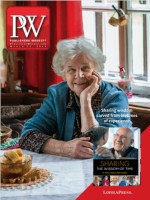Candace Bushnell is back! This is not about 1997’s internationally bestselling Sex and the City book or the TV series and films that followed. This is about now and Bushnell’s new book, Is There Still Sex in the City?, in which she asks the titular question.
And Bushnell does it with her original team at Grove—a homecoming of sorts, according to all involved. “It’s a return to her roots—that sly, sharp reportage, the acerbic essays in her particular hybrid style, blending journalism and fiction,” says her editor Elisabeth Schmitz, v-p and editorial director of Grove.
Is There Still Sex in the City? features a first-person narrator, newly divorced, over 50, facing the prospect of dating in this age of apps. She buys two standard poodles, moves between New York City’s Upper East Side and a rural town called the Village, and proceeds to chronicle her adventures and those of her friends—with younger men; older men; $15,000 Russian face creams—in chapters with titles such as “Middle-Aged Madness” and “The Tinder Experiment.”
“In the winter of 2016,” Schmitz says, “Heather Schroder [owner of Compass Talent and Bushnell’s longtime agent] called me about Candace coming back to Grove and sent over her Tinder article that had appeared in Cosmo magazine.” The assignment from the Cosmo editor, stated in the article, was, “Get on Tinder and then tell me if you still believe in love.” Schroder calls the Tinder article “an interesting springboard for getting back into Candace’s style of composite characters and experiences.”
Agreeing to another book by Bushnell was easy for Grove publisher Morgan Entrekin, who edited Sex and the City and is pleased that she’s back. “It’s the old Candace—edgy, ironic” he says. “She’s so smart and funny.”
Entrekin goes on to say that he negotiated the deal for Sex and the City with Bushnell’s then-boyfriend Ron Galotti, who was publisher of Vogue and the inspiration for Mr. Big, at a party for Will Self at the Bowery Bar. She next connected with Schroder, who was at ICM.
“Bret Easton Ellis told me Candace was looking for an agent,” Schroder says. “We had lunch. For me, it was love at first sight.”
Sex and the City (which Grove bought for $25,000) went on to sell “probably three to four million in all formats,” according to Entrekin. “And Four Blondes [Bushnell’s follow-up with Grove] sold about 600,000–700,000.”
What did Entrekin pay for Bushnell’s latest? “Not nothing,” he tells me. “It was a great deal for both of us.”
Is There Still Sex in the City? is autofiction, telling stories of women who have had lives and are continuing to have them. The target audience is obvious, but Schmitz says that the book is resonating in-house with the younger people—a whole new generation—and adds that the book is hilarious. “It’s joyous, but there’s also a melancholy; aging involves sadness. There’s death, divorce. Candace wanted to explore this and come back to her literary roots, to have the editorial attention.”
By the summer of 2017, there were finished chapters and a complete outline of the book. The manuscript went into production in October 2018 and Is There Still Sex will pub in August.
Entrekin says it will be interesting to see how it goes. “It’s not a sequel,” he emphasizes. “The characters are completely different.”
In addition to U.S. rights, Grove bought Canadian and translation rights. It’s been acquired in eight international territories so far, in addition to Canada and the U.K.: Bulgaria, Croatia, Czechoslovakia, Finland, France, Germany, Russia, and Serbia.
Bushnell left Grove after Four Blondes for a successful run with Hyperion, because, Schroder says, she wanted to “expand out, work in different forms.” Schroder adds, “She’s grown as a writer. Now she wants to go back to her beginnings, observing people and writing about them.”
Bushnell says that the impulse for this book is the same one she had for Sex and the City: the realization that different ages are times of passage in women’s lives. “The 30s are about establishing yourself, your career; the 40s are when you’re pushing forward, making money, and they’re about how the world sees you and how you see yourself. I wanted to look at this later stage in life, a time when women can focus on themselves. I saw it with me and my friends. It’s a time of real upheaval. Getting older for women is nature’s way of saying it’s your time, your creative time. You can’t rely on romantic tropes”.
Bushnell was first published at age 19. “I would write about anything,” she says. “I know about things you wouldn’t imagine. Ask me about microwaves! I wanted to write fiction but couldn’t figure out how to get paid for it, so I developed this style and wrote about women in their 20s. And it seems to work for this topic of middle age: women over 50 having a life. Heather and I talked it over, and it felt like something new and unexplored”.
Judy Hottensen, associate publisher at Grove, calls this book a happy reunion. She was at that fateful Bowery Bar party and went on the road with Bushnell for Sex and the City. “I can relate to where we all are now in life with this new book,” she says. “We have come full circle.”
Marketing plans include a 20-city tour, TV bookings, and swag at BookExpo. “The budget is fluid,” Hottensen says. “And Candace has an amazing social media program. She’s come into her own; she’s a one woman show and ready for action.”
An August party in the Hamptons has been mentioned. I angle for an invite. With age, I tell Hottensen, comes shamelessness. “Of course” is Hottensen’s response. “As Candace says, ‘If not now, when?’ ”



 Volume 266
Issue 12
03/25/2019
Volume 266
Issue 12
03/25/2019





